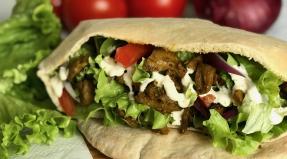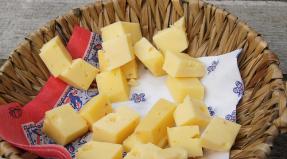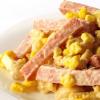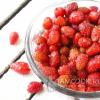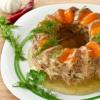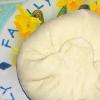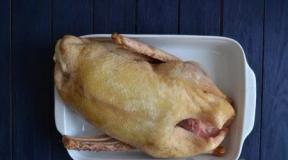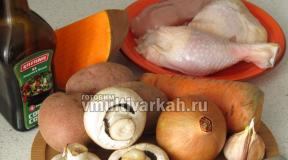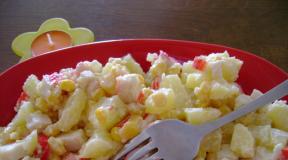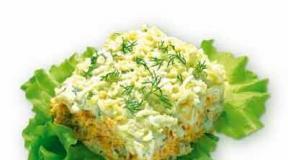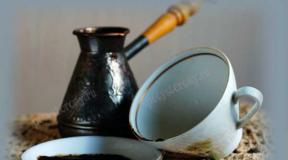How to pickle cucumbers in a plastic barrel. Pickling cucumbers in a barrel: step by step recipes with photos
Wooden containers have been used in the household and, in particular, in the kitchen since ancient times. Today, the art of the cooper has ceased to be artisanal, although individual craftsmen who make oak barrels, tubs and bowls are still found in countryside. In general, the manufacture of these containers necessary for conservation has been put on an industrial level, although the volumes of such products are not particularly large due to low demand.
However, as long as there is a need to harvest vegetables by pickling and pickling, there will be tubs. Why are wooden oak barrels better than metal galvanized or plastic ones, which are much cheaper? It’s worth starting with the fact that oak, from which barrels are usually made for pickling, has tanning substances in the wood structure, which can be understood even by the name of the wood species. They are the best natural preservatives, thanks to which cucumbers, tomatoes, cabbage, mushrooms or fish are stored in brine for a long time.
Microbes that cause decay quickly die in containers made of oak boards, as an unfavorable environment is created for them.. Besides, wooden barrels give new aromas and flavors to stored products, completely changing the taste of preservation for the better. This is the advantage of wood over metal or plastic, which can slightly worsen the taste of the blanks.
How to prepare a wooden barrel for food storage?
The first thing to remember is that if last year's preservation is eaten, in no case should the barrel be left until the next harvest with the remains of the brine or, moreover, empty, even if washed. First of all, you need to completely remove the traces of the finished workpiece, whether it be pickles or sauerkraut. Next, we wash the container and, when it dries slightly, pour 2-3 kilos of quicklime into it (depending on the volume, 1 kilogram is enough for a small barrel).
pouring hot water, gradually bringing its level almost to the brim, and cover with a lid, after which we wait about 3 hours. Then empty the container and rinse several times with clean water. For washing large barrels, it is best to use a round brush with a long handle, especially in cases where you need to wash the containers with lime water.
Store wooden oak barrels and tubs must be filled with water so that they do not dry out. Moreover, in modern products of coopers, hoops, as a rule, are made of stainless steel, and dampness is not terrible for them. But wood soaked in water swells and retains liquid well. Remarkably, clean drinking water in oak barrels and jugs it never spoils. However, if you suddenly found a forgotten empty barrel and found small gaps between the boards in it, do not rush to get rid of the container. It is enough to pour water again for a day, and the wood will swell again, closing the cracks.

When preparing wooden barrels for pickles, repeat the operation with quicklime if you notice a musty smell. But before pouring out the resulting lime "milk" after 3 hours, you need to wash the bottom and walls with this solution. Only then rinse the container several times, all the time changing the water to clean. If mold is suddenly found, it is better to pour 100-200 grams of caustic soda or ash into a bucket of water, resulting in lye, which is used to wash the barrel or jug, after which it is thoroughly steamed and rinsed with clean water.
If jars are steamed or sterilized before rolling pickles or jams microwave oven, then it is impossible to perform such an operation with a barrel. But disinfection can be done in a different way. To do this, we take bleach and dilute it in water, at the rate of 100-200 grams for every 10 liters. Then we wash the barrel with the resulting solution. As a result, you will achieve perfect cleanliness, but the container will smell very unpleasant. To get rid of the smell, fill the barrel several times hot water which drains when it cools down.
It is completely different to do with a newly purchased barrel. First of all, make sure to purchase at least a month before the start of conservation. Fill a new container to the top with water and keep filled for at least 2 weeks, emptying and refilling to the brim every 5 days. Next prepare a large number of boiling water. Lay freshly cut branches of wormwood and juniper at the bottom of the barrel. Fill the container with boiled water and cover with a lid, then cover with a blanket. So that the water does not cool for a long time, we burn large cobblestones on the fire and periodically throw them into the barrel, slightly lifting the lid. Having devastated, we put on Fresh air, and before or cucumbers, you need to burn a little sulfur at the bottom, again covering it with a lid.
Pickling cucumbers in an oak container
After harvesting, you need to carefully sort out the cucumbers and choose those that are not yet fully ripe, because in a wooden barrel they will quickly reach the desired degree of maturity. At the same time, we set aside for salting only the same size. This is one of the basic rules when preserving in a barrel, so that the vegetables are sorted by size, which is not necessary when spinning in glass container. Soak cucumbers in cold water for at least 2.5 hours (we do not use a barrel for this purpose), but if purchased vegetables are being prepared for pickling, it is better to double the time.

Further, before that, we rub the walls and bottom in the barrel with peeled and finely chopped garlic (100 grams), which is previously ground with salt. Then, at the bottom, completely covering it, we throw horseradish leaves, 100 grams of currant leaves and the same amount of horseradish chopped into strips. There we also place 0.5 kilos of dill chopped into 10-centimeter segments and 50 grams of tarragon slices, as well as 10 grams of bitter pepper cut into rings. Then tightly, in layers, we set the cucumbers vertically, as the barrel is filled, we place horseradish leaves between the vegetables and the walls around the entire circumference.
In the middle of the laying, we place the same number of spices and spices as at the beginning, and the remaining third - on top, again covered with horseradish. For brine, we take about 70 grams of salt per liter of water for small and medium cucumbers, but if the vegetables are large, you need to take 10 grams more salt. For every 10 kilos of cucumbers, you will need approximately 2 liters of filling, which is filtered through cheesecloth before filling the barrels. We cover the container with a lid or a circle with oppression. It is better to store pickles in a cool place, while canning takes place at room temperature.
Salting tomatoes in a wooden tub
As in the previous recipe, everything starts with sorting, since the vegetables must be the same size. A spreader is also not needed. Before salting the tomatoes in a 10-liter barrel, put horseradish and currant leaves so that they completely cover the bottom. From above we pour the horseradish root chopped into strips mixed with a large cut of dill. We do not use garlic, as it can cause souring of tomatoes due to the presence of sugar in the composition. We begin to lay cleanly washed tomatoes tightly, on their side, avoiding deformation and tearing of the skin.

Before laying the second row, shake the barrel slightly from side to side so that the vegetables already placed in it lie more tightly. When the container is almost filled to the top, pour a new portion of chopped dill and horseradish root on top, the volume is the same as the original one. We cover everything again with horseradish and currant leaves. For pouring in cold water, by thoroughly mixing, dissolve 60 grams of salt per liter. Actually, for 10 liters of conservation, this is exactly the amount of solution that will be needed. Salting of tomatoes in a barrel occurs under oppression and with closed lid within one and a half months.
I have never met a person who would be indifferent to all sorts of homemade pickles. And now I'm not talking about the sterilization process and canning, but about a plate of pickled or salty sweets. One can only argue here - someone likes it sourer, and someone likes more sugar.
But they stand apart pickled cucumbers(not salted and not pickled!), they are also called cask. This is where all lovers of winter sweets from a jar fall into two camps - some love such cucumbers to shivers in their knees, while others, sorry, stink, and generally fu!
I'm among the first! Crispy, vigorous, filled with juice, only such a cucumber is delicious to eat a glass of vodka, and only such a cucumber is worthy of a vinaigrette.
While I was a city girl and had only a refrigerator at my disposal, I often visited the market in a tent from a local state farm - there, in addition to sweet onions and juicy carrots, sauerkraut and real barrel cucumbers. I bought 10 pieces at once and ate half right in the car, splashing everything around with brine)))
And when we got a cellar, I thought - is it possible to cook the same delicious cucumbers at home?
Of course, at first I tried to get oak barrel for salting, but then I realized - I started from the wrong side! First of all, you need a recipe! And I got it! All the details of the preparation of barrel cucumbers were told to me by an aunt in the market, from whom I always bought these cucumbers. True, by revealing this secret to me, she lost me as a buyer - after all, now both barrel cucumbers and sauerkraut I can do it myself
Although, I doubtfully wrote down the recipe, but my head was spinning “It can’t be so simple!” Well, it’s true, I couldn’t believe that in order to get such yummy on a plate, cucumbers must first turn sour (roughly speaking, go bad!), And then magically become a delicacy!
Indeed, the recipe is so primitive that if cucumbers are already selected, consider that half the battle is done!
Which cucumbers to choose? Of course tasty, strong, without flaws, straight from the garden.
It is believed that cucumbers with a thick skin and black spikes are best suited for pickling and pickling - special pickling varieties (breeders even bred the common Masha variety). Such cucumbers are well stored (last year a couple of buckets quietly stood in the cellar until March), they remain crispy and vigorous.
But gentle, with a velvety fluff - they are better in salads. In salting, they are stored poorly, and if such cucumbers are fermented, then rather quickly they turn into sour soap. Although, if you do not plan to store blanks until spring, you can try this recipe with any cucumbers.
And the size? Yes, when you're making barrel cucumbers, size matters! It has been verified that the larger the cucumber, the more smoothly magical processes take place inside it. Of course, you need to understand that the cucumber has not grown to the size of a zucchini, it has become covered with a thick peel, turned yellow on one side, and inside there are huge seeds, there are simply large-fruited varieties - a cucumber can be at least 30 centimeters in length, but remain juicy, tender and not overripe.
One misfortune with such long cucumbers - what to ferment them in? Here, an ordinary three-liter jar, and a cucumber sticks out of the neck ... And how many such specimens will fit in a jar - three, four?
Therefore, my choice is plastic buckets-containers. They visit different sizes(from half a liter to 12!), with sealed lids, the walls are transparent enough to peep at what is happening inside (it is easy to control the turbidity of the brine and its level), but most importantly, the diameter of the bottom and the neck do not differ much.
This container is four liters. And here is the cucumber that stuck out of three-liter jar- yes, you can put at least a dozen of such cucumbers there in a pile!
But it doesn’t matter what variety you choose for pickling cucumbers - they all need to be washed and soaked in a cool clean water for at least 2 hours, preferably at night. Cucumbers will absorb water and “drink” less brine.
In the meantime, let's get on with the tasty accents! We will collect on the beds fragrant herbs- dill (tender twigs and tough stems, flowers and ripe umbrellas), garlic (both heads and green feathers), horseradish leaves, parsley (whole with roots or only leaves), cilantro (leaves, flowers, green seeds), mint sprigs , basil, thyme. Don't forget the blackcurrant leaves.
If there are no beds of their own, and the grandmother is far away in the village, then there is a direct road to the market, fragrant “brooms” with everything you need are sold there.
Also goes well with cucumbers. Bay leaf, hot pepper and peppercorns.
It's also a good idea to add cherry leaves. In our region, such a cherry is called a sweet cherry or “cherry on a leg”, its leaves are small, but there is plenty of flavor.
I visited friends at the dacha with garden shears and brought a real cherry bouquet - leaves into blanks, chop the twigs into chips for hot smoking, eat the berry!
By the way, if you didn’t use all the leaves at once, put them in a bag and store in the refrigerator - they lie for several weeks; you can also save the "extra" leaves of blackcurrant and horseradish.
But real cask cucumbers are therefore cask cucumbers - they are with the taste of a barrel, ideally - oak. We will “deceive” - add dry oak leaves to the bucket. Of course, they are not as fragrant as fresh ones, but what can you do if real oaks do not grow here. After all, do we use dry bay leaves in the kitchen?
There are almost no problems with dry oak leaves - you need to buy an oak broom. Just don't buy it beautiful packaging in the supermarket (suddenly it is processed with something or old), look near the city baths - they always sell brooms made of birch, fir, juniper, and sometimes oak. I know, one uncle is specially brought oak brooms from the Far East.
Such a broom is enough to pickle several buckets of cucumbers and it will remain to take a steam bath))
Well, let me tell you about the salt! Take a large pickling and NOT IODIZED! With iodized blanks do not stand and quickly turn sour.
As you can see, there are more words and theory here, let's get down to business!
Plastic sealed buckets (or glass jars, if you suddenly do it in them) wash with soda, you do not need to sterilize. The more of the right bacteria left, the better the fermentation process will go.
At the bottom we put a mixture of herbs, a few peppercorns, a horseradish leaf, fill up to half with cucumbers, laying them as tightly as possible. Again a layer of herbs, again cucumbers and more greens on top. We cover with a sheet of horseradish, without fanaticism we ram the contents.
Pour salt on top - 1 tablespoon per liter of container (my buckets of 4 liters each means 4 tablespoons), and fill it with UNBOILED filtered water, you can use it from a bottle, you can use mineral water, you can use spring water, but without bleach. Leave for half an hour and add water if necessary.
We leave the buckets (jars) at room temperature, prudently they need to be put in a bowl, on a large plate or baking sheet - they can leak. Loosely cover with lids or a saucer (from dust and insects), shake a couple of times in the evening so that the salt is distributed faster throughout the entire volume of the brine.
The next day, foam will appear on the surface, someone will say “oh, oh, turn sour!”, But in fact, the process has started!
And after another day or two, the brine will become cloudy - close the lids tightly and put them in the basement or in the refrigerator if you made a small batch. Now the cucumbers should stand at a temperature not higher than 8-10 degrees for a month. Do not store them at room temperature!
Over time, the brine will brighten a little, but still remain cloudy, and bright green cucumbers will turn brown.
As I said, such cucumbers stand until spring, do not turn sour, do not grow moldy, only the taste becomes more vigorous. The hare even joked that he would carry a fork and a stack with him, drink and eat, because there is in the cellar, and going to heat the house is just along the way)))
Enjoy! Have a bite!
Previously, in almost every village family, cucumbers were salted in barrels for the winter, and barrels of a fairly large volume (from 50 to 100 liters) were used. Families were large, and this product was also eaten large quantities.  For salting, you need to take late-picked cucumbers. The best raw materials for pickling are cucumbers 8-15 cm long, that is, unripe fruits with small seed chambers and underdeveloped seeds. Freshly picked cucumbers are soaked, periodically changing the water (no more than 6 hours), and washed. Seasonings are also thoroughly washed. Dill is cut into pieces 15-20 cm long. Horseradish roots and garlic are peeled. Prepared seasonings are placed on the bottom of the barrels and on top of the cucumbers. If the barrels hold more than 100 liters, seasonings are placed in the middle.
For salting, you need to take late-picked cucumbers. The best raw materials for pickling are cucumbers 8-15 cm long, that is, unripe fruits with small seed chambers and underdeveloped seeds. Freshly picked cucumbers are soaked, periodically changing the water (no more than 6 hours), and washed. Seasonings are also thoroughly washed. Dill is cut into pieces 15-20 cm long. Horseradish roots and garlic are peeled. Prepared seasonings are placed on the bottom of the barrels and on top of the cucumbers. If the barrels hold more than 100 liters, seasonings are placed in the middle.
The walls of the barrel are rubbed with garlic. Cucumbers are tightly packed in barrels: what more cucumbers fits in the dish, the higher the concentration of lactic acid during fermentation and the better the pickles will be preserved.
The oak tub must first be prepared. Before pickling, cucumbers must be sorted and cucumbers of medium and small size preferably with thin skin. Selected cucumbers must be washed and soaked in cold (preferably spring or well) water for 3-5 hours. Initially soaked cucumbers during the salting process do not wrinkle and do not form voids.
300 grams of dill
- 50 grams of horseradish leaves
- 30 grams of garlic
- 5 grams of hot pepper
We cover the filled tub with a lid and leave it for 2-3 days in a room with room temperature. The process of pre-fermentation begins, if necessary - the brine needs to be topped up. Then we clean the oak tub with cucumbers in a cold, dark room, where the cucumbers will slowly pickle for 30-45 days. After the specified period of time, it's time to go and check the readiness of pickles. Pickle in an oak tub unique taste and unusual crunch. Pickling cucumbers in a wooden barrel
The best for pickling cucumbers is 6-8% brine.
Before pickling, cucumbers are sorted by size, washed and soaked in water for 5-8 hours. In the process of locking, cucumbers swell and become elastic. Such cucumbers, when salted, will not wrinkle and will not form voids inside.
Prepared cucumbers are placed in a barrel tightly, and not in a loose embankment. The laying is carried out as follows: the bottom of a wooden barrel is lined with spices, then a layer of cucumbers is laid, then again a layer of spices, and so on to the top. We close the cucumbers with spices on top, pour them with brine, put a napkin, a circle and a load on it.
All spices (spices) used in salting must be fresh. Fresh spices have bactericidal properties and contain the largest number vitamin C. If all the necessary spices are not available, you can replace one with another. However, they must be used in such a way that the harmony of taste and aroma is not disturbed.
During salting, it is necessary to remove the mold daily and wash the circle and the napkin in boiling water once every two to three days. The quality of the finished product depends on the purity of the surface of the brine.
Pickled cucumbers in a pumpkin
The composition of the brine: 40 g of salt, 1 liter of water.
The smallest cucumbers are selected, up to the ovary; it is good to salt the cucumbers of the last fees, they are dense and elastic. Choose a mature dense pumpkin, preferably round, so that it can be put on the table. The stalk is cut out together with a part of the pulp adjacent to it in the form of a round lid. Scoop out the seeds with a spoon through the hole. Freshly picked prepared cucumbers are tightly placed inside the pumpkin and poured with weak brine. Spices are not added. Close the pumpkin with wooden sticks. Then lowered into the middle wooden tub in which cucumbers are pickled in the usual way. Cucumbers in a pumpkin get delicate fragrance and good taste.
Pickled cucumbers with vinegar
Prepared as above, put the cucumbers in a barrel or jar with fragrant herbs and pour hot brine into which vodka and grape vinegar. . The next day, add cucumbers with cold brine, clog the bottom of the barrel (or tightly close the jar) and put in a cold place. Cucumbers prepared in this way are stored for a long time. To prepare a brine for 10 liters of water, take 500 g of salt, 1 cup of vinegar and 3/4 cup of vodka.
Salted cucumbers
For salting, you need to take medium-sized, with thin skin, fresh cucumbers(best of all - taken from the beds on the day of salting). Sort the cucumbers, discard the yellowed and spoiled ones, wash cold water. It should be remembered that wooden barrels must be prepared, namely, line the bottom with washed oak, blackcurrant or cherry leaves, put dill, horseradish, tarragon, garlic. Then lay the cucumbers in a vertical position in dense rows. Between the rows, make gaskets from leaves and seasonings, close the barrel tightly, clogging the upper bottom. Through the hole made in the bottom, pour in the brine and cork with a wooden cork. Cucumbers can also be pickled in a tub. After pouring the brine, the cucumbers, so that they do not float up, should be covered with a tightly fitting wooden circle, a load should be placed on it, which, however, should not put pressure on the cucumbers. The brine should cover the cucumbers by at least 3-4 cm. Cover the tub with a clean cloth and store in a cool place. For a bucket of water - 600 g of salt, 50 g of dill, 5 g of tarragon, 0.5 pod of red pepper, 1 head of garlic , 0.5 horseradish root. 
Salted cucumbers
Select and wash the cucumbers, put them in a jar, shifting them with seasonings (dill and garlic). Pour cucumbers with chilled brine (2-3 tablespoons of salt per 1 liter of water). Cucumbers will be ready in 2 days. Can cook salted cucumbers during few hours. To do this, cut off the tips of the cucumbers and pour hot brine.
pickled cucumber recipe
For pickling, cucumbers with pimples, with an uneven surface, are selected. To keep bright green color, pour boiling water over them and immediately lower them into cold water. The natural color will be preserved and fermentation will be accelerated if the cucumbers are shifted with leaves. white cabbage or put a piece of black bread in the dishes. If you add a little mustard to the brine, then pickles will become tastier and last longer.
Cucumbers will not grow moldy if you put chopped horseradish on top.
Sort the cucumbers, selecting overripe and damaged ones. Soak them for 5-7 hours in cold water. At the bottom of the salting dishes (barrel, pan, bucket), put a layer of spicy plants: dill with inflorescences, tarragon, horseradish root, garlic, hot pepper and cherry leaves, then lay cucumbers vertically, spices again on them, then cucumbers again, and above spicy plants, fill with brine, cover with a clean cloth, a wooden circle and put the weight. Store cucumbers at 0-3°C.
To prepare the brine small cucumbers for 10 liters of water you need to take 600 g of salt, and for large ones - 700 g.
The approximate ratio of spices per 20 kg of cucumbers: dill - 600 g, horseradish root - 100 g, garlic - 60 g, hot pepper - 100 g, tarragon - 100 g. 
Pickled cucumbers in a tub
The oak tub must first be prepared. Before pickling, the cucumbers must be sorted and cucumbers of medium and small size, preferably with thin skin, should be selected. Selected cucumbers must be washed and soaked in cold (preferably spring or well) water for 3-5 hours. Initially soaked cucumbers during the salting process do not wrinkle and do not form voids.
All spices must be fresh and clean. We suggest using the following spices for pickling cucumbers in an oak tub: black currant leaves, cherry leaves, horseradish leaves, dill, garlic, pepper, tarragon.
Before salting, spices need to be prepared. Garlic is peeled and finely chopped, and then pounded with a wooden pusher. Dill and tarragon are cut in half.
For 10 kg of cucumbers you need:
300 grams of dill
- 50 grams of horseradish leaves
- 30 grams of garlic
- 5 grams of hot pepper
- 50 grams of blackcurrant leaves
- 50 grams of cherry leaves
To increase the shelf life of pickles, you can put chopped cucumbers on the bottom of the tub. sugar beet(based on 200 grams of beets per 10 kg of cucumbers).
The product and spices are laid as follows - we measure a third of all spices and put on the bottom of the tub (horseradish leaves, currants, cherries, dill, garlic and pepper), then we put a vertically dense layer of cucumbers, then the second third of all spices, then cucumbers again. Put the rest of all the spices on top of the cucumbers, covering everything with horseradish leaves. On top of the horseradish we put the wooden oppression attached to our oak tubs, and on it the load and pour everything with brine.
The brine must be prepared based on the following proportion: 2 liters of brine for 10 kg of cucumbers. For 2 liters of brine you need 140 grams table salt. We recommend that you dissolve the salt in a small saucepan in warm water, and then strain the brine through a dense (or gauze) cloth. The brine in the oak tub should completely cover the layer of cucumbers.
We cover the filled tub with a lid and leave it for 2-3 days in a room with room temperature. The process of pre-fermentation begins, if necessary - the brine needs to be topped up. Then we clean the oak tub with cucumbers in a cold, dark room, where the cucumbers will slowly pickle for 30-45 days. After the specified period of time, it's time to go and check the readiness of pickles. Pickled cucumber in an oak barrel has a unique taste and unusual crunch.
Bon Appetit!
In ancient times, as you know, there were no glass and plastic containers for pickling and harvesting vegetables and fruits for the winter. All kinds of clay barrels and tubs were used. Yes, and special seasonings (vinegar, citric acid) to increase the shelf life have not yet been invented. Therefore, it was carried out with the use of herbs and fresh spices. It is thanks to the use of containers made from natural materials, and seasonings grown in their garden, the blanks turned out to be unusually tasty, crispy and fragrant. This article details the barrel. In extreme cases, in the absence of the necessary containers, you can use a large enamel pan or plastic tub.

in a barrel: preparation of ingredients
Vegetables must be freshly picked and good quality. Select fruits of the same size without any damage (do not salt overripe and too big cucumbers). Wash them and soak them in cold water for 3-4 hours.
The recipe for pickling cucumbers in a barrel is designed for a large amount of product. As a rule, up to 100 kg of vegetables are harvested immediately in wooden containers. But then you have to take care of the place where the pickles will be stored. Usually the barrel is placed in the basement or cellar. With a smaller amount of raw material available, you can use small spools, plastic kegs or enamel pots. In urban environments, this is more practical and expedient. And if you're worried about the smell of artificial plastic being absorbed by the cucumbers, line the container. large piece thick polyethylene film, spreading it so that the edges hang freely outward.
Pickling cucumbers in a barrel: recipemarinade
Boil water, and then dissolve the salt in the cooled liquid. For each liter, 70-80 g of the mentioned product will be needed. Often spring or well water is used. But in this case, it also needs to be boiled.
Recipe for pickling cucumbers in a barrel: bookmark products
Among the mandatory seasonings are coarsely chopped pieces of garlic, umbrellas fresh dill in the flowering stage, chopped horseradish root and its leaves, bitter Bell pepper, leaves of black currant and cherry, parsley or celery. Mix all the ingredients and grind a little with each other. Place a third of the mass on the bottom of the container, cucumbers on top, trying to fill the space more tightly with them.

The next layer is seasonings, and then cucumbers again. Cover the vegetables with the rest of the greens. In this case, you need to leave a little free space to the edges of the container. Pour the prepared mass with cold brine, cover with a cotton cloth and press down with a wooden circle. Be sure to put a small weight on it so that the cucumbers are completely immersed in the solution and do not float up. Place the container in a cool place where the temperature does not exceed 5-7 °C. Periodically inspect the pickle for mold. In this case, sprinkle dry mustard on top of the cucumbers, after carefully removing the whitish coating. After 25-35 days, crispy cucumbers should be ready. How good they are with hot boiled potatoes!
Pickled cucumbers in barrels (basic recipe)
Products
Cucumber 100 kg
dill 3 kg
horseradish leaves 1 kg
horseradish root 300 g
black currant leaves 1 kg
garlic 10-15 heads
red hot pepper 10 pods
Brine for 10 liters of water:
salt (for large cucumbers) 840-950 g
salt (for medium cucumbers) 730-840 g
salt (for small cucumbers) 620-730 g
For pickling, you need to take cucumbers late varieties. Cucumbers 8-15 cm long are best suited for pickling, that is, unripe fruits with small seed chambers and underdeveloped seeds.
Freshly picked cucumbers are soaked, periodically changing the water (no more than 6 hours), and washed. The leaves are also washed thoroughly.
Dill cut into pieces 15-20 cm long
Horseradish roots and garlic cleanse
Prepared seasonings are placed on the bottom of the barrels and on top of the cucumbers. If the barrels hold more than 100 liters, then the leaves and spices are also placed in the middle. The walls of the barrel are rubbed with garlic
Cucumbers are tightly laid out in barrels: the more cucumbers fit in the dish, the higher the concentration of lactic acid during fermentation will be and the better the pickles will be preserved.
If cucumbers are salted in barrels with a double bottom, then it is inserted after filling the barrel, and the brine is poured through the tongue-and-groove hole.
When salting in open barrels, cucumbers are covered with a linen napkin, a wooden circle of hardwood and oppression are placed.
To prevent dust from entering the barrel, it is also covered from above.
After filling with brine, dishes with cucumbers are first kept in a room with a temperature of 18-20 ° C, at which the fermentation process takes place most quickly.
After a few days, the cucumbers are transferred to a cold place where fermentation ends.
In an ordinary cellar, fermentation ends in 30-35 days. In the first days after the start of fermentation, there is a rapid release of gases, and the level of brine rises, and then drops sharply.
It is necessary to ensure that the cucumbers are covered with brine at all times. If necessary, the brine should be added (for 1 liter of water - 20 g of salt and 9 g of citric acid). Properly cooked cucumbers are light green or yellow-green in color; they are hard, crunchy; easily break in half, and on the fault do not have voids; they have a pleasant sour-salty taste and smell of spices.
Failures in pickling cucumbers are associated primarily with the conditions of fermentation and subsequent storage. Pickled cucumbers have low acidity, therefore, during storage, especially at elevated temperatures, they often soften, lose their taste and smell. The lower the storage temperature, the less likely adverse events. Optimum temperature for storage of cucumbers about 1 °C. The quality of pickles sometimes deteriorates due to improper selection. Firstly, not all varieties of cucumbers are suitable for pickling. Both too small (less than 7-8 cm) and very large cucumbers are not suitable. small cucumbers do not acquire the appropriate taste and quickly soften. Large cucumbers with developed seeds begin to turn yellow and soften faster. Voids in fruits occur both in the field with strong growth and during fermentation. The quality of pickles largely depends on the water - the water must be hard. The quality of pickled cucumbers during storage may suffer due to the development of mold and membranous microorganisms on the surface of the brine. The mold quickly decomposes lactic acid, which is the preservative element of pickles. Putrefactive microorganisms quickly develop in such an environment - cucumbers soften, becoming unsuitable for food. To prevent this undesirable phenomenon, the film is periodically removed, and the napkin, circle and oppression are thoroughly washed and scalded with boiling water. Mold does not develop if the surface of the brine is sprinkled with dry mustard powder.
